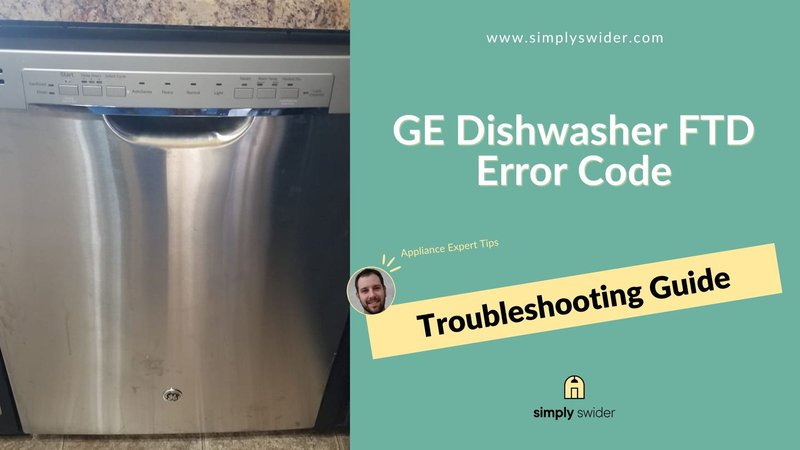
Understanding what these codes signify is crucial. In the case of the GE dishwasher, an F2 error could indicate a drainage issue, potentially caused by a clogged filter or a blocked drain hose. Think of it like a clogged sink that just won’t let water pass through. If left unresolved, it could lead to more significant problems, not only with your dishwasher’s performance but also with your kitchen’s plumbing. So, rather than brushing it off, it’s worth exploring the potential causes and taking steps to address the problem.
What Does the GE Dishwasher Error Code F2 Mean?
The F2 error code is essentially a distress signal from your dishwasher. When this code appears, it’s your appliance’s way of telling you there’s a drainage problem. Much like a car’s check engine light, it’s an alert that something’s amiss, and further investigation is needed. The dishwasher’s internal sensors have detected that the water is not draining as it should, which could stem from several underlying issues.
One common cause is a blocked drain hose. Over time, food particles, soap scum, and other debris can accumulate in the hose, creating a blockage that prevents water from draining properly. Imagine if you tried sipping a thick milkshake through a straw, but the straw was full of clumps; that’s essentially what’s happening inside the dishwasher. Clearing out that blockage might just solve the issue.
Another potential culprit could be a clogged or dirty filter. Just like a coffee filter that gets overwhelmed with too many grounds, your dishwasher filter can become clogged with food particles and other residues. This prevents water from passing through efficiently, triggering the F2 error code. The solution could be as simple as cleaning or replacing the filter, allowing the water to flow freely again.
Can Ignoring the F2 Error Cause Bigger Problems?
You might be wondering, “What’s the worst that could happen if I just let it be?” Ignoring the F2 error might seem tempting, especially if the dishwasher still seems to be somewhat functional. But here’s the kicker: unresolved drainage issues can lead to more severe and costly problems down the line. Imagine a small leak in a garden hose—if left unchecked, it can turn into a substantial tear, wasting water and money.
If the drainage issue persists, it can cause water to back up inside the dishwasher. This stagnant water can lead to unpleasant odors, residue buildup, and even mold growth within your machine. Additionally, continuous water overflow can damage the dishwasher’s electronics or even cause leaks, which could ruin your kitchen floor or cabinetry. This slippery slope could eventually lead to the need for extensive repairs or, worse, a complete dishwasher replacement.
Moreover, by ignoring the error, you might be inadvertently increasing your energy bills. A dishwasher that’s struggling to drain will use more power to try and complete its cycle, not to mention the inefficient water usage. So, spending a little time investigating the root cause can save you a lot of hassle and money in the long run.
Steps to Fix the F2 Error Code
So, what can you do about it? Tackling the F2 error code might sound daunting, but with a little patience, you can often resolve the issue yourself. Start by inspecting and cleaning the dishwasher’s filter. This is usually located at the bottom of the machine. Remove it and wash away any debris or food particles that might be causing the clog. This step alone can sometimes clear the error code.
Next, check the drain hose. Ensure it’s not kinked or blocked by external objects like large utensils or dish racks. If there’s a visible clog, gently disconnect the hose and flush it out using warm water. Think of it as giving your dishwasher a detox, allowing it to breathe and function smoothly again.
If these steps don’t resolve the issue, consider checking the dishwasher’s air gap, if applicable. This small, often-overlooked component prevents backflow of water into the dishwasher. Ensuring it’s clean and free from obstructions can sometimes resolve the problem. And remember, if DIY solutions aren’t your cup of tea, there’s no shame in calling a professional. They’re equipped to handle more complex issues and can get your dishwasher back in tip-top shape.
Preventing Future F2 Errors
As with most appliance woes, an ounce of prevention is worth a pound of cure. Keeping your dishwasher in good working order can prevent future F2 error codes and extend the lifespan of your machine. Regular maintenance is key, much like keeping a car serviced to ensure it runs smoothly.
Make it a habit to routinely clean the dishwasher’s filter. Depending on usage, this might mean every few weeks or once a month. Also, be mindful of what goes into the dishwasher. Rinsing off large food particles before loading can prevent clogs before they start. Think of it like flossing your teeth to prevent cavities.
Occasionally running an empty cycle with a dishwasher cleaning solution can also help remove buildup and keep things flowing smoothly. It’s akin to giving your appliance a spa day—helpful in maintaining efficiency and performance. By taking these simple preventive measures, you can avoid the hassle of dealing with error codes in the future and enjoy a trouble-free dishwashing experience.
In conclusion, while it might be easy to shrug off the F2 error code, addressing it is crucial to maintaining your dishwasher’s efficiency and avoiding costly repairs. With a little attention and care, you can keep your kitchen running smoothly and ensure that pesky error codes are a thing of the past.